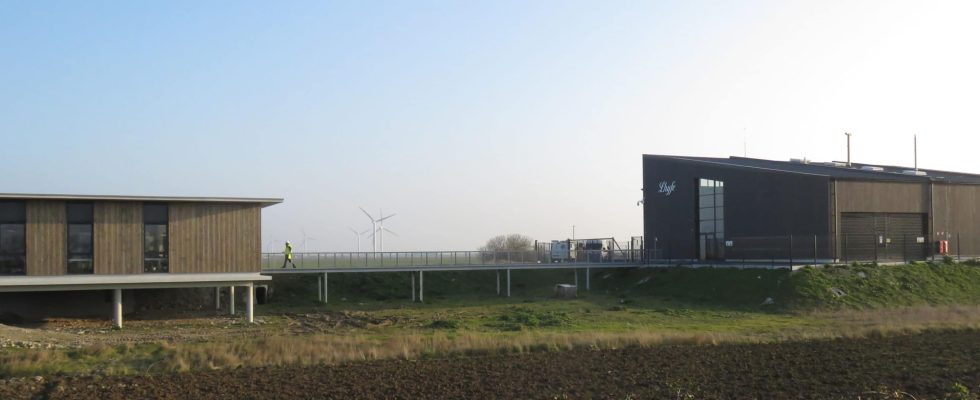The wind blows hard on the Vendée coast and feeds the blades of three wind turbines. With a total power of 7.5 megawatts (MW), the latter are connected by cable to an enigmatic black building whose entrails draw some 3 cubic meters of water daily from the nearby Atlantic Ocean. It is here, in Bouin (Vendée), that the alchemy of green hydrogen takes place within the largest plant in France. “Unlike electricity, there is no market or infrastructure to which we just have to connect, explains Ghislain Robert, commercial director of the start-up Lhyfe. Everything is to be built and sold by us. themselves.”
Inaugurated in September 2021, this complex producing 350 kilos of hydrogen per day should increase to 1 tonne in 2024. Its operation is just as simple on paper as it is complex in practice. “We worship safety more than patents!” loose with a smile Ghislain Robert. From pumped seawater, engineers remove salt from minerals in a tangle of colorful pipes of all sizes. Then the hydrogen is separated from the oxygen using an electrolyser powered by the wind turbines which, in the form of water vapor (therefore non-polluting), is evacuated through the roof. In this sense, this product can be described as “green” and not “black” (from coal, very polluting), “gray” (based on natural gas, CO2 emitter) or “yellow” (via nuclear ).
Finally, trucks collect this 99.9% pure hydrogen, pressurized to 350 bars. Distribution takes place within a radius of 150 kilometres. Here, to supply buses in Le Mans (Sarthe); there, in trucks in La Roche-sur-Yon (Vendée) or a hundred handling machines around Nantes. “It is only with this regional distribution strategy for a single large production site that we can return to our costs”, assures Ghislain Robert. Without regulation or market price, hydrogen trades around 10 euros per kilo – enough to propel a car over around 100 kilometres. For the time being, the target segment remains that of professional and intensive transport, on the road as well as at sea. “The hydrogen engine is expensive to buy, but does not have the disadvantages of wear and charging time “, explains the technician.
25 projects in progress
Created in 2017 in Nantes, Lhyfe does not intend to stop in Vendée. A second plant has just been inaugurated in Buléon (Morbihan) before another in Occitania, still connected to wind turbines, but this time with a process of electrolysis of waste water. The company with 180 employees went public in May 2022 before proceeding with a capital increase of 120 million euros. “Today, we have increased financial resources and new partners to implement the deployment of numerous production sites for ecological and accessible hydrogen throughout Europe since we have 25 projects in the works”, continues Matthieu Guesné, the founder and CEO of the company which aims for profitability by 2024.
About fifty kilometers from Bouin, Lhyfe is also testing another solution called “Sealhyfe” off the port of Saint-Nazaire. This octagonal offshore platform, about twenty meters in diameter, has a daily production capacity of 400 kilos of hydrogen. Here again, thanks to a wind turbine, the yellow floating plant can desalinate seawater and then separate the oxygen and hydrogen. “This production at sea is a huge technological challenge that we wanted to take up to show our know-how”, concludes Matthieu Guesné. Innovation is the spearhead of the world of hydrogen.
This article is taken from the special issue “Energy transition: let’s invest together!” available on newsstands June 29.
